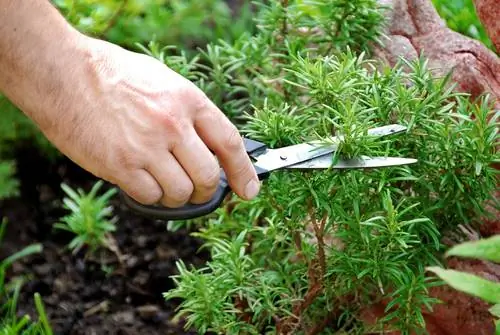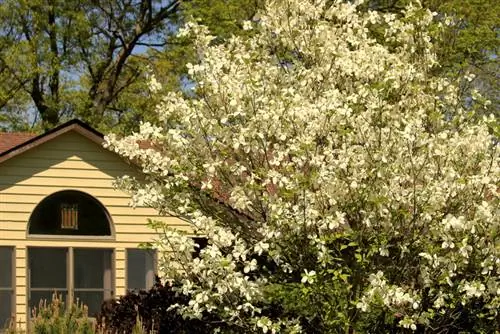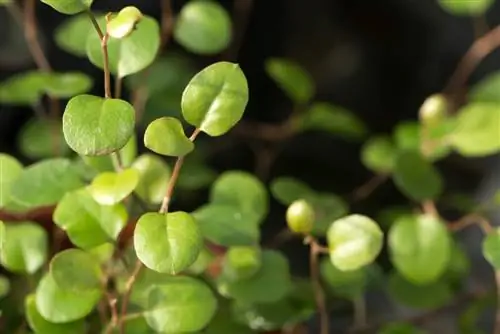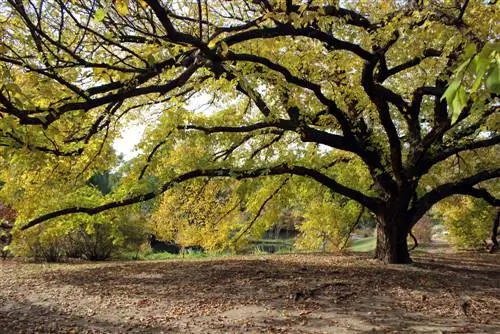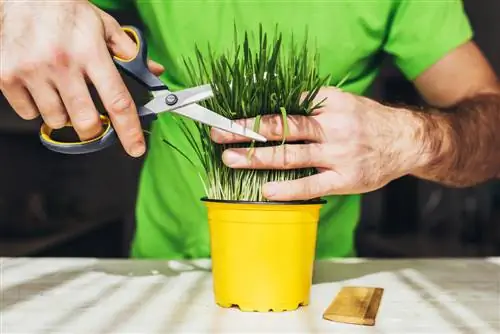- Author admin [email protected].
- Public 2023-12-16 16:46.
- Last modified 2025-01-23 11:21.
Regular harvesting is not enough for rosemary to thrive vitally and he althily for many years. Only in combination with careful pruning care does the Mediterranean herb plant become a feast for the senses. Read this tutorial on when and how to properly cut rosemary.

When and how do I cut rosemary?
Rosemary should ideally be cut in spring after the main frost period or after the flowering period. Cut out branches that are too close together and shorten remaining shoots by about a third or half in the herbaceous area. Avoid cutting into woody wood.
Crop cutting is not enough
Rosemary is classified as a subshrub. The popular culinary herb plays in the same league as lavender, thyme or bearded flowers. Plants in this category thrive perennially, gradually becoming woody from the base. It is the herbaceous areas that renew themselves every year and where the spicy leaves sprout. Without a cut, the woodiness takes hold, so that a rosemary bush becomes visibly bare.
Although you continually trim your rosemary when harvesting, the herb needs extensive maintenance pruning so that woodiness does not gain the upper hand.
Background
Rosemary stingy with sleeping eyes
Do not cut rosemary into the wood. As exuberantly as the Mediterranean herb plant gifts us with flowers and aroma, it is just as stingy when it comes to creating sleeping eyes. Botanists refer to buds in a resting state as sleeping eyes. Only when active parts of the plant fail due to a cut, storm or frost damage do sleeping buds perk up and replace lost shoots. In contrast to many native trees, rosemary does not use the iron reserve. As a result, if the woody areas are cut too deeply, the plant will not sprout, or will sprout only very slowly.
Cutting types and dates
A magnificent rosemary bush is the result of harvesting and maintenance pruning. In an old, neglected plant, woodiness is on the rise. Under certain conditions, you can revitalize old rosemary with targeted pruning. The following overview summarizes recommended cutting types with suitable dates:
| Cut style | Goal/Occasion | best date | alternative date |
|---|---|---|---|
| Harvest cutting | Premium quality harvest | just before the flowering period begins | all year round (behind glass) April to August (in the bed) |
| Conservation cut | thinning out, preventing woodiness | Mid-May to mid-June | after the flowering period |
| Rejuvenation cut | revitalize old rosemary | before budding | May (after the Ice Saints) |
Harvest whole shoots
The spiciness of your rosemary at the highest level when the flowering period begins soon. Classic varieties such as 'Veitshöchheim' or 'Arp' develop their buds between April/May and June/July, depending on the weather and site conditions. Cold-sensitive hanging rosemary takes until June before it begins to bloom. Even when harvesting, you should keep an eye on shape and vitality. How to harvest rosemary correctly:
- The best time is during the mid-morning hours when the morning dew has evaporated
- Ideally cut off entire shoots instead of cutting off individual needle leaves
- Harvest rosemary evenly and do not cut it on one side
When harvesting the small potted rosemary, you complete the maintenance cut at the same time. For this purpose, thin out damaged or dried branches. Give the plant a hemispherical shape so that sunlight can penetrate into the interior for densely leafy growth.
Excursus
Dried rosemary remains aromatic
Shortly before the flowering period begins, the aroma content is at its peak. Now you should harvest and preserve your annual supply of rosemary. In contrast to many other herbal plants, rosemary hardly loses its flavor when the branches are air dried. Tie the shoots together into a small bouquet with raffia ribbon. Hang it upside down in a dark, airy place. Over the next 2 to 3 weeks, check the binding material from time to time to make sure it doesn't come loose. Finally, strip off the spicy needles and store the harvest in a dark screw-top jar.
Cutting rosemary in spring
If your rosemary has spent the cold season in frost-free winter quarters, the time window for maintenance pruning opens in early spring. If you keep the herb plant outdoors, please wait until after the Ice Saints before cutting. If delayed ground frost hits freshly cut shoots, the plant will not survive the dilemma unscathed. If you prefer to be on the safe side, write down the date in the care plan only after the flowering period. This is how you cut rosemary in an exemplary manner:
- Thinning out branches that are too close and pointing inwards
- Cut off stunted, wilted, limp shoots at the base
- Cut back remaining shoots by a third or half
- Make the cut a short distance from the woody area
Dried rosemary branches are, strangely enough, often the result of excessive watering and waterlogging. In this case, you should repot the affected plant into fresh substrate after cutting. Place some shards of pottery on the bottom of the pot to prevent future waterlogging. From now on, only water your rosemary when the soil is noticeably dry.
Tip
You should postpone the cutting time if the heavens have opened their floodgates beforehand. Moisture not only affects the aroma content of fresh rosemary sprigs. Soaked shoots are not suitable for drying because mold can quickly form on damp plant tissue.
Rejuvenate old rosemary
Without regular cutting, a rosemary will age within a few years. Garden plants that have been forgotten in a sunny niche are often affected. A sparse foliage only promises a low harvest yield. However, the neglected herb plant has proven to be robust and hardy. Reason enough to prescribe a rejuvenation cut instead of immediately cutting down the Mediterranean survival artist. How to proceed professionally:
- The best time is shortly before budding begins
- Clear out all dead wood level with the ground
- Cut out largely bare, woody and weak shoots
- Aged branches are slimmed down by diverting them to a side shoot
Cutting into old wood is taboo on all subshrubs. Nevertheless, a woody shoot signals courage to live by allowing a lateral, young, herbaceous shoot to sprout. This is the perfect prerequisite for a derivation cut with a rejuvenating effect. Cutting takes place where old and fresh wood branches. The image below illustrates the skillful cutting. Then add a generous portion of compost or a complete organic fertilizer and water again.
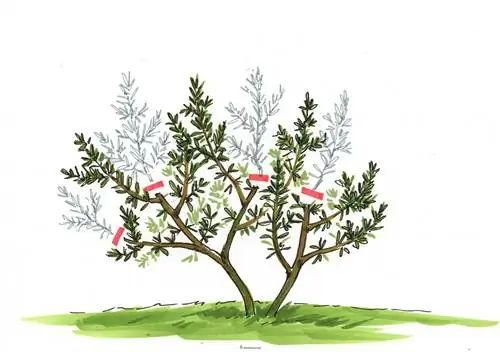
Redirect senescent branches to a lower side shoot that grows outwards. Be sure to avoid cutting into old wood because rosemary will no longer sprout there.
Which scissors are suitable?
On young rosemary in the pot, conventional household scissors are sufficient for harvesting and maintaining it. It is best to trim adult herb plants with bypass pruning shears, rose or boxwood shears. These scissor models work with two sharp cutting edges and leave smooth interfaces.
Fashionable herb scissors with 5 to 7 blades are not recommended for cutting rosemary. Such constructions are primarily suitable for parsley, chives or salad.
Meticulous cleanliness and sharp cutting edges ultimately qualify the tool for cutting rosemary. Germs and pathogenic pathogens are waiting to enter the plant tract via contaminated scissors and knives. Dull blades leave frayed, bruised interfaces that serve as a welcome target for fungal spores and pests. Sharpen the cutting edges regularly, manually or mechanically. Before each use, clean the cutting tool with hot water and disinfect it down to the last niche with Sagrotan (€15.00 on Amazon) or spirit.
Excursus
Be aware of the risk of confusion with rosemary heather
Rosemary heather (Andromeda polifolia) leads us astray with its slender, lanceolate leaves. In fact, it is an evergreen heather plant with highly toxic ingredients. In Germany, the nasty small shrub can be found primarily in low mountain ranges, the Bavarian Alps and in heath and raised moor areas. Only in autumn is the risk of confusion with real rosemary averted because the leaves turn bright red or intense yellow.
Frequently asked questions
There is a mature rosemary growing in our garden that we would like to transplant. What should be taken into account when changing location?
The best time to transplant a rosemary is in spring. Cut all shoots back by half. Be sure to avoid cutting into old wood. Inevitably, a lot of root mass is lost, which is compensated for by pruning. Please ensure a continuous and plentiful water supply. Drought stress is the most common cause of rosemary transplant failure. We also recommend a balanced supply of nutrients from April to the end of July with compost or a complete organic fertilizer.
When and how do I harvest rosemary correctly?
You can basically harvest rosemary all year round, as long as the plant is large enough and spends the winter behind glass. Fresh shoots are particularly aromatic. Shortly before the flowering period begins, the Mediterranean herb plant gives you the tastiest harvest. Rosemary lovers harvest the annual supply in one go in spring (April/May) and hang the branches upside down to dry. However, the pretty and tasty flowers are only suitable for fresh consumption.
Is rosemary hardy?
As a Mediterranean herb, rosemary is only very hardy to a limited extent. Ideally, the aromatic subshrub is cultivated in a pot and overwintered frost-free behind glass. In regions with mild winters, there is the option of growing rosemary in the garden. The plant survives the cold season with extensive winter protection. Place a hood made of jute or garden fleece over the branches. Please cover the root disc with a thick layer of leaves and needle twigs. In early spring, cut all shoots back by half.
I keep my large rosemary pot outside the kitchen window in winter. Whole branches repeatedly dry out and turn brown. Should I cut the plant back?
It is far too warm at the kitchen window in winter for your rosemary. Brown, dried branches indicate that fungi are spreading on the weakened herb plant. Changing location can solve the problem. Rosemary should overwinter frost-free but cool at temperatures between 5 and 10 degrees Celsius. Water sparingly and do not apply fertilizer until the end of March. After the Ice Saints, clear out the plant. Thin out dead shoots and cut back the remaining branches in the herbaceous area by half.
Our rosemary bush is 1.50 meters tall, sprawling and woody at the bottom. Now in May the flowering season is coming to an end. Can I cut the plant back now?
The best time for cutting is in spring after the main frost period. After the flowering period, pruning is possible as long as you do not do it in high summer heat or extremely dry conditions. First, clear out all dead wood. You can cut back all remaining shoots to just above the woody area. Ideally, give the bush a hemispherical shape for light-filled growth.
The 3 most common cutting mistakes
Rosemary's good-natured pruning tolerance suggests that the Mediterranean herb is forgiving of any mistakes. Unfortunately, this is not the case, as the following table shows. A wrong timing or a cut too deep into the wood will bring the opulent spice plant to its floral limits. Familiarize yourself with the 3 most common cutting mistakes here and benefit from tried-and-tested tips for prevention.
| Cutting errors | malicious image | Prevention |
|---|---|---|
| cut into wood | Growth depression, total failure | always intersect in the herbaceous area |
| no maintenance cut | premature lignification | cut back by half and thin out in spring |
| cut in autumn or late winter | frostbitten rosemary | cut in the bed according to the ice saints |

Tip
Semi-woody cuttings are ideal for propagating rosemary. Select 10 cm long cuttings and defoliate the lower half. In a pot with potting soil, the offshoots find time and leisure to root vitally. A transparent hood made of foil or glass, which you ventilate for a few minutes every day, is helpful for the process. Keep the substrate constantly slightly moist and do not apply fertilizer.

